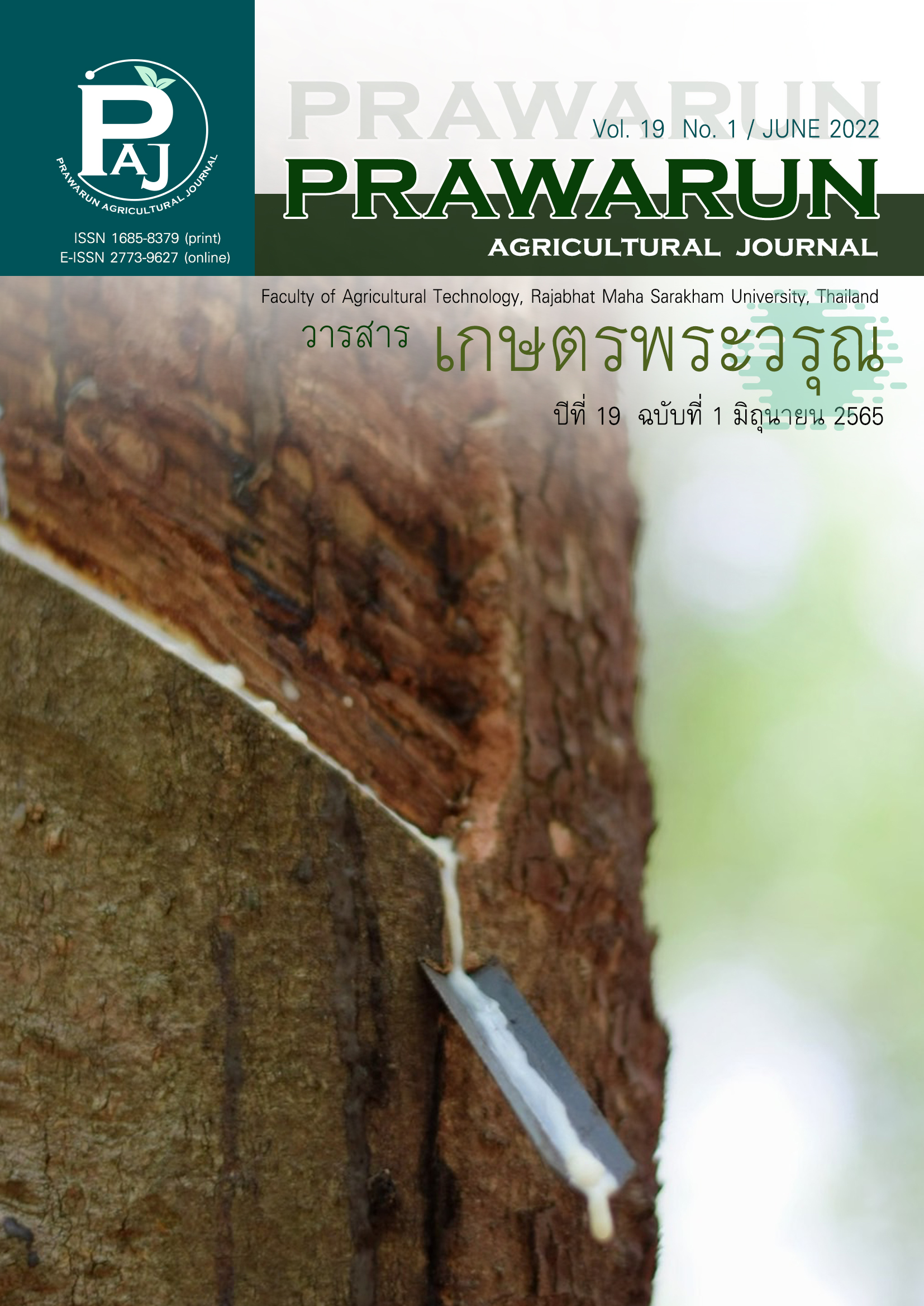การพัฒนาน้ำพริกจากสาหร่ายน้ำจืดเทา (Spirogyra neglecta (Hassall) Kützing)
Main Article Content
บทคัดย่อ
งานวิจัยนี้มีจุดประสงค์เพื่อพัฒนาสูตรอาหารสุขภาพจากสาหร่ายเทา Spirogyra neglecta โดยใช้สาหร่ายเทาอบแห้งบดละเอียดเป็นส่วนผสมในการเตรียมอาหาร 7 ชนิด ได้แก่ น้ำพริกตาแดง น้ำพริกเผา น้ำพริกหนุ่ม น้ำพริกนรก น้ำพริกหมู ข้าวแตน และข้าวเกรียบ วิเคราะห์คุณภาพทางด้านกายภาพ เคมีและจุลินทรีย์ ของผลิตภัณฑ์ที่ได้ ในการเปรียบเทียบกับชุดควบคุมที่ไม่มีการใส่สาหร่ายเทา พบว่าผลิตภัณฑ์จากสาหร่ายเทาทุกชนิดมีปริมาณโปรตีนและเยื่อใยสูงกว่า ทั้งนี้พบว่าผลิตภัณฑ์ที่ให้ปริมาณคาร์โบไฮเดรต โปรตีน ไขมัน เถ้า และเยื่อใย สูงสุด ได้แก่ ข้าวเกรียบ น้ำพริกหมู น้ำพริกตาแดง ข้าวแต๋น ข้าวเกรียบ และน้ำพริกตาแดง ตามลำดับ ผลการวิเคราะห์ทางจุลชีววิทยา พบว่าผลิตภัณฑ์จากสาหร่ายทั้งหมดมีปริมาณแบคทีเรียเช่นเดียวกับปริมาณยีสต์และราน้อยกว่า 1x10 CFU/g ซึ่งเป็นไปตามมาตรฐานของกรมวิทยาศาสตร์การแพทย์ นอกจากนี้ได้ทดสอบการยอมรับผลิตภัณฑ์ของผู้บริโภคโดยการประเมินด้านประสาทสัมผัส พบว่าค่าเฉลี่ยความชอบของคุณลักษณะด้านสี กลิ่นรส รสชาติ และเนื้อสัมผัส และความชอบโดยรวม อยู่ในระดับสูงที่ 7.68 สิ่งที่ได้จากการศึกษาครั้งนี้แสดงให้เห็นว่าสาหร่ายเทาเป็นแหล่งอาหารที่สำคัญสำหรับการพัฒนาเป็นอาหารเพื่อสุขภาพซึ่งควรได้รับการส่งเสริมในเชิงพาณิชย์ต่อไปในอนาคต
Article Details
เอกสารอ้างอิง
Amornlerdpison, D., Duangjun, K., Kanjanapothi, D., Taesotikul, T., & Peerapornpisal, Y. (2012). Gastroprotective activity of Spirogyra neglecta (Hassall) Kützing. KKU Science Journal, 40(1), 236–241.
AOAC. (2000). Official methods of analysis of AOAC International (17th ed.). Maryland: AOAC International.
Dwaish, A. S., Yousif, Y. D. M., & Lefta, S. N. (2016). Use of Spirogyra sp. extract against multidrug resistant bacterial pathogens. International Journal of Advanced Research, 4(7), 575–579.
Department of Medical Sciences, Ministry of Public Health. (2017). Microbiological guidelines criteria for food and food packaging, Vol. 3. Accessed December 6, 2021. Retrieved from http://bqsf.dmsc. moph.go.th/bqsfWeb/index.php/bio/ (in Thai)
Giordano, P., Scicchitano, P., Locorotondo, M., Mandurino, C., Ricci, G., Carbonara, S., . & Matteo Ciccone, M. (2012). Carotenoids and cardiovascular risk. Current pharmaceutical design, 18(34), 5577-5589.
Maturin, L., & James, T. P. (2001). Bacteriological analytical manual, Chapter 3: Aerobic plate count (8th ed.), Revision A. Accessed June 20, 2021. Retrieved from http://www.fdago–v/food/foodscience research/laboratorymethods/ucm063346.htm
Mesbahzadeh, B., Rajaei, S. A., Tarahomi, P., Seyedinia, S. A., Rahmani, M., Rezamohamadi, F., Kakar, M. A., & Moradi–Kor, N. (2018). Beneficial effects of Spirogyra Neglecta extract on antioxidant and anti–inflammatory factors in streptozotocin–induced diabetic rats. Biomolecular Concept, 9(1), 184–189.
Okunowo, W. O., Abiola, O. O., Josiah, A. I., Lukman O. A., & Ifeoma, E. U. (2018). Antimicrobial, antioxidant potential and chemical composition of the methanolic extracts of Spirogyra setiformis and Navicula species. Journal of Scientific Research and Development, 17(1), 15–20.
Pacheco, P., Ferreira, A. F., Pinto, T., Nobre, B. P., Loureiro, D., Moura, P., Gouveia, L., & Silva, C. M. (2015). The production of pigments & hydrogen through a Spirogyra sp. biorefinery. Energy Conversion and Management, 89, 789–797.
Panpipat, W., Sukchoo, S., Santong, R., Wuthsi, W., & Chaijan,, M. (2009). Characteristics of fried–restructured pork added with Gracilaria seaweed (Gracilaria fisheri). Paper presented at the 35th International conference on congress on science and technology of Thailand, Kasetsart University, Bangkok, Thailand. (in Thai)
Peerapornpisal, Y., Makakornkaewkeyoon, S., Pongsirikul, S., Khûm klang, X., Lertleelakitcha, N., & Boonsinchai, B. (2005). Potential of freshwater macroalgae as food and medicine (Research report). Chiang Mai: Chiang Mai University. (in Thai)
Peerapornpisal, Y., Panyoyai T., & Amornlerdpison, D. (2012). Antioxidant and anti–inflammatory activities of Spirogyra neglecta (Hassall) Kutzing. KKU Science Journal, 40(1), 228–235.
Petchwattana, N., Boonsong, P., Wichian S. N., & Acharry, S. (2019). Antimicrobial packaging from biodegradable plastics and essential oils blends. The Journal of Industrial Technology, 15(1), 85–99.
Saekoo, J., & Panich–Pat., T. (2017). The study of optimum conditions for microalgae culture in piggery wastewater and algae oil production. Veridian E–Journal, Science and Technology Silpakorn University, 4(4), 41–52. (in Thai)
Sitthiwong, N. (2019). Pigment and nutritional value of Spirogyra spp. in Sakon Nakhon, Nakhon Phanom and Mukdahan Provinces. Progress in Applied Science and Technology, 9(1), 10–21.
Watts, B. M., Ylimaki, G. L., Jeffery, L. E., & Elias L. G. (1989). Basic sensory methods for food evaluation. Ontario: The International Development Research Centre.
Wangcharoen, W., Kusirimatanoon, T., Mangumphan, K., Tongsiri, S., & Amornlertpison, D. (2017). Development of Spirogyra neglecta (Hassall) Kützing jelly drink. Paper presented at the 9th International conference on sciences, technology and innovation for sustainable well–being (STISWB 2017), Kunming University of Sciences and Technology, Yunnan, China.
Yosboonruang, A., Duangai, A., Amorlerdpison, D., & Viyoach, J. (2020). Screening for biological activities of Spirogyra neglecta water extract. Walailak Journal of Science and Technology, 17(4), 359–368.


